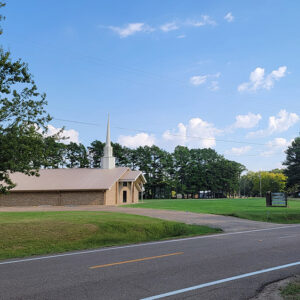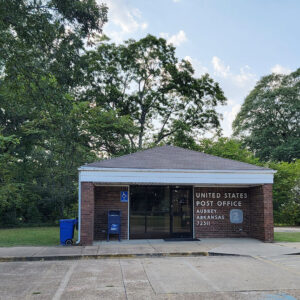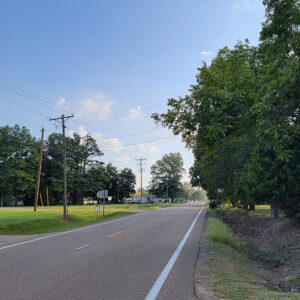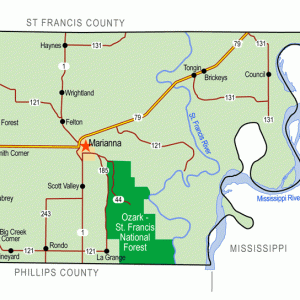calsfoundation@cals.org
Aubrey (Lee County)
| Latitude and Longitude: | 34°43’00″N 090°54’01″W |
| Elevation: | 203 feet |
| Area: | 0.33 square miles (2020 Census) |
| Population: | 108 (2020 Census) |
| Incorporation Date: | June 30, 1966 |
Historical Population as per the U.S. Census:
|
1810 |
1820 |
1830 |
1840 |
1850 |
1860 |
1870 |
1880 |
1890 |
1900 |
|
– |
– |
– |
– |
– |
– |
– |
– |
– |
– |
|
1910 |
1920 |
1930 |
1940 |
1950 |
1960 |
1970 |
1980 |
1990 |
2000 |
|
– |
– |
– |
– |
– |
– |
351 |
267 |
204 |
221 |
|
2010 |
2020 |
|
|
|
|
|
|
|
|
|
170 |
108 |
|
|
|
|
|
|
|
|
The town of Aubrey stretches along State Highway 121 in western Lee County. Formed early in the twentieth century when the railroad came through the area, the town was not incorporated until 1966. Although Lee County’s population is predominately African American, Aubrey remains more than two-thirds white.
Lee County was sparsely populated when it was first formed in 1873. Most of the county land consisted of cotton plantations—converted from slave labor to tenant farmer labor after the Civil War—and oft-flooded lowlands. The construction of railroads changed the county’s character early in the twentieth century. The Missouri and North Arkansas (M&NA) Railroad, linking Joplin, Missouri, to Helena (Phillips County) on the Mississippi River, brought much commercial traffic through the county. The refueling stop that became the town of Aubrey was created in 1907. Named for the son of a local resident, Dr. W. B. Snipes, the town quickly sprang to life, beginning with a community barbecue offered to celebrate the arrival of the railroad, which was completed in 1909, the same year that Aubrey received a post office. McNulty Lake, to the west of Aubrey on Big Creek, was a frequent recreation spot for residents and visitors.
In 1910, the town erected a two-story school. That same year, a Methodist Episcopal South church was formed. The town soon had a hotel, a store, a cotton gin, a saw mill, and a drugstore, as well as the train depot and various residences. A Missionary Baptist church was formed in 1929, and a Church of Christ was organized around 1930.
The community, though unincorporated, continued to thrive through the first half of the twentieth century. After World War II, however, changing economic conditions threatened the survival of the settlement. A school for veterans of the war opened in 1948 but did not remain open for long. In 1949, the M&NA ceased service through the area. The old school house was replaced by two modern structures in 1950, but school consolidation led to abandonment of the school. The last graduating class from Aubrey High School held commencement exercises in 1963, as the school district was consolidated with that of Marianna (Lee County), the county seat. Elementary grades continued to be taught in Aubrey until 1981, when all instruction was moved to Marianna.
A community fair, sponsored by the Young Business Men’s Club and the Future Farmers of America, was held in October 1954, but there is no record of subsequent such events. In 1966, the town was incorporated, providing a water system, a sewage system, garbage service, and a fire truck for the volunteer fire department. The Methodist congregation ceased meeting in May 1971 after an earthquake damaged its building the previous year. However, the Church of Christ dedicated a new building in 1979, and the Missionary Baptist congregation did the same in 1986.
In 2013, businesses in Aubrey included the Aubrey Country Store and Grill, Bennett Tractor Parts, and the Farmers Supply Company. The population of Aubrey, as counted by the 2010 census, consisted of 170 residents, of whom 116 were white and fifty were black.
For additional information:
Lee County Sesquicentennial Committee. Lee County History. Dallas, TX: Curtis Media Company, 1987.
Steven Teske
Butler Center for Arkansas Studies
 Aubrey Church
Aubrey Church  Aubrey Post Office
Aubrey Post Office  Aubrey Street Scene
Aubrey Street Scene  Lee County Map
Lee County Map 




Mr. Vondran, I remember Otto Williams’s store. My daddy, John A. Pruett Jr., grew up and went to school with Otto Williamss’ son, Auto Williams. I guess Auto Williams would have been your uncle. Auto Williams’s name inspired one of my character’s names in my book, The Lime Green Falcon.
I remember Aubrey from my youth with great fondness. My grandfather and grandmother lived in town and owned a grocery store and “fillin’ station” on the left as you entered town. (My grandfather was John Sharp Williams.) My mother, Nellie Williams, and my father, Andrew “Gump” Vondran, met as a result of the M&NA Railroad connecting the towns of Aubrey and Moro. One of the few social activities of the day was a regular community dance that drew members from various communities together. My mother graduated from Aubrey High School in 1935. My uncle, Otto Williams, took over the store and raised a large family that grew up in Aubrey. Great times, great fun, and great memories of Aubrey!